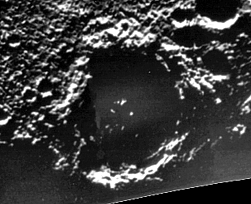 |
Planetary Characteristics |
 from Hermograph Press
from Hermograph Press
|

This planet moves the fastest of all nine planets in the Solar System. It is named for the fastest of the ancient Roman gods, the messenger of the gods, Mercury (in Greek mythology, Hermes). See All Things Mercury's Hermes description.
We here at Hermograph Press have been observing Mercury for over 5 decades. It doesn't get the PR that most of the other planets get--lost in their glow, as it were. So starting here we are going to take you on a journey, a series of Mercurian orbits, each one passing through five aspects of this planet. At the end of each Web page, click on the NEXT ORBIT link to continue on your way, until you return back here. Enjoy the trip!
Note: These pages are under continual refinement.
The Basic Facts
|
|
|
| Size | 4879 km, or
about 3050 miles in diameter. This makes Mercury about 38% the diameter
of Earth, about 40% bigger than our moon, and the second smallest
planet in the solar system, if you still want to include Pluto (we don't...). The iron core is quite large in relation to the whole planet--1800-1900 km in radius, leaving a 500-600 km silicate crust (the equivalent area of earth, the mantle and surface lithosphere, is much greater in percentage of the earth's radius than the core). This makes Mercury's core the second densest in the solar system, slightly behind Earth's. |
| Gravity | Also 38% of Earth values. You'd weigh 38 pounds for every 100 pounds of Earth weight. By coincidence, this is the same weight you'd have on Mars, a larger planet. The reason is Mercury is denser--has more stuff per cubic inch on the average--than Mars. The more stuff (in science terms, more mass), the more gravitational pull there is, and therefore the more you will weigh, all other things being equal. As written above, the density of Mercury is almost the same as Earth's, 5.5 grams/cubic centimeter. This signifies it probably also has an iron core, like Earth. |
| Escape Velocity | You'd have to move at the speed of 4.2 kilometers per second to escape Mercury's grasp. On Earth you'd have to get moving at a speed of 11.2 km/s. |
| Albedo | Although it gets more and brighter sunlight than any other planet, it reflects a mere 11% of the sunlight that hits its surface. This makes Mercury a dark world, the darkest major body in the solar system. |
| Rotation (Day) and Revolution (Year) | It's
a LONG workday, from an Earth perspective. It takes 58.6 Earth days
for Mercury to spin once on its axis. This is 2/3rds of its orbital
period (year). The planet spins counterclockwise (like the Earth) and
also orbits counterclockwise. HOWEVER, it would be about 176 Earth
days between sunrises! Why? Suppose you start out with the sun in view in front of you from some point of Mercury's orbit. It would be noon Mercury time. We notice that it had been lined up with a certain star in the background. Very very slowly, because of Mercury's rotation, we'd see the sun move across the Mercurian sky, just as the Earth spin makes the sun and stars seem to move across our sky. The orbital motion (revolution) also changes from where we view the Sun and stars, both on Mercury and Earth.. So as the Sun appears to move from East to West in our daytime sky, it also appears to move through the star fields as well. On Mercury, we'd see the Sun gradually separating from the star it was lined up with when we started, as it moves across the Mercurian sky. On Earth our planetary revolution makes the Sun move slowly through the Zodiac constellations through one Earth year. When one complete spin (day) of the planet has occurred, 58 Earth days later, the star is once again at the noon position. But 58 days later Mercury is at a different part of its orbit; it has only completed 2/3rds of an orbit. We have to look in a DIFFERENT direction to see the Sun, off to one side of where it was before. It will be almost 120 more days before IT is back at the noon position, too. [This is the very same phenomenon that makes the Moon take ~30 days to repeat its phases but only 27 days to return to the same constellation/star position in the sky, the fact that as the moon revolves around us, we are also changing our viewpoint by revolving around the Sun. An analogy to this using clock hands is found in Issue 1 of The Classroom Astronomer. This makes for an interesting kind of sky overhead on Mercury, especially if you were at one of the two special "hot spots" on Mercury, Caloris Basin. Because Mercury's orbit is not circular, the size of the sun will change dramatically over the "day." The Sun would rise small and grow in size as it moves to the overhead position. Furthermore, because Mercury moves faster when closer to the Sun than when it is farthest away, the apparent motion of the Sun in the sky caused by the orbital motion is briefly faster than the shifting caused by the planet's spinning. At the time of closest approach to the Sun, the differences in speed cause the Sun to temporarily move BACKWARDS(!) in the sky. Then it resumes its normal westward motion, begins to shrink in size by sunset, 88 Earth days after Sunrise. Then, for 88 days, it is night. On Earth, things are not so dramatic. We don't spin one and a half times per year, we spin just over 365 times per year. The difference between two successive noon appearances of the Sun is but 23 hours and 56 minutes, not days! How many Mercury days and years old are you? By the stars, a Mercury day is 58.6 Earth days or 0.16 Earth years. A Mercury year is 0.24 years. For each full Earth year you are alive, you are 6.25 Mercury-days-old, and 4.17 Mercury-years-old. A forty-four Earth-years-old on his birthday would be 275 Mercury-days-old and a whopping 183.33 Mercury-years-old! |
| Orbital Characteristics | On average it moves at 29 miles per second,
fastest planet in the solar system. Mercury has the second-most non-circular, elliptical orbit of all the original nine planets. Only tinier Pluto's orbit is less circular. On the mean, Mercury is 0.387 Astronomical Units away from the Sun (1 A.U. is the Earth's average orbital distance, just under 93,000,000 miles or 149.6 million kilometers). This means it is about 36 million miles from the Sun. Light, the fastest moving object in the universe, takes about three minutes to reach Mercury after it leaves the Sun, 8.3 minutes to reach Earth. And speaking of the Sun, it would appear from 2 to more than three times as large in Mercury's skies than in Earth's. Why? Because of that elliptical orbit, which has an eccentricity (non-circularity factor) of 0.206; Mercury can be as close to the Sun as about 28 million miles, and as far away as about 43 million miles. This also changes the amount of sunlight that hits the little world. At its farthest orbital position Mercury gets 4X as much sunlight as Earth. At its nearest point, it gets 11X! Visiting Mercury? Bring your sunblock!! Compared to the Earth's orbit, Mercury's orbit is tipped about 7 degrees. Unlike the Earth, which has its axis tipped 23 degrees with respect to its orbital plane, Mercury is not tipped at all with respect to its own orbit. It therefore has no seasons. For the technical among you, the longitude of the ascending node (the direction in space, seen from the Sun, where Mercury goes from below the ecliptic plane of Earth's orbit to above it) is 48o. The longitude of perihelion (the point in space as seen from the Sun where Mercury is closest to the sun) is 77o. But these do drift in time. |
| Surface Conditions | It's HOT! No, It's COLD! No, It's BOTH! On the day side, temperatures peak at 800 oF (425oC) and drop to -275oF at night (-170oC). Because of Mercury's eccentric orbit and the resonance between rotation and revolution, the places around longitudes 0 and 180 degrees get 2.5X as much radiation as places near longitudes 90 and 270 degrees. Yet, near Mercury's poles appear be small deposits of ice, in craters that are in perpetual shadow. These were detected by radar (1991, using the Arecibo antenna, and the Goldstone radio telescope along with the Very Large Array in New Mexico) and have not been confirmed by any visual sightings. Recently, ice was detected by the Messenger mission in orbit around the planet. (We'll come back to this point in a future ORBIT.) The ice present is due to being perpetually in crater rim shadows and may have come from either volcanic outgassing or bombardment by comets.
 |
| Atmosphere | Though Mercury's gravity is too weak to hold onto an atmosphere; nevertheless there is a trace of one. There appears to be an extremely miniscule amount of Helium (42% of the total Mercurian atmosphere), an equally miniscule amount of Sodium (some researchers dispute the presence of Sodium at all), 15% Oxygen, with 1% of the total Neon and Argon, a grand total atmospheric pressure of only 1/150th that of Earth (about 10-15bar--1 bar is Earth normal air pressure). It is not enough to act as a blanket, transferring daytime heat to the night side as happens on Earth. It is not enough to stop even the smallest meteoroid from hitting the surface and making a crater. It is enough, apparently, though, to cause very very weak and dim auroral glows, detectable only by sensitive instruments on-board the Mariner 10 spacecraft. The atmosphere is believed to be temporarily trapped particles of the solar wind. |
| Miscellaneous | Mercury has no known moon. It does have a very weak magnetic field, but strong enough to deflect the sun's solar wind with a bow shock (like that of Earth, or of a boat moving through water). The field is only 1/30th that of Earth's. |
| Logo | The
symbol of the planet, used by astrologers and astronomers alike, is
described as based either on Mercury the god's wand or cadeuceus around
which are two snakes, or Mercury in his winged hat.
 |